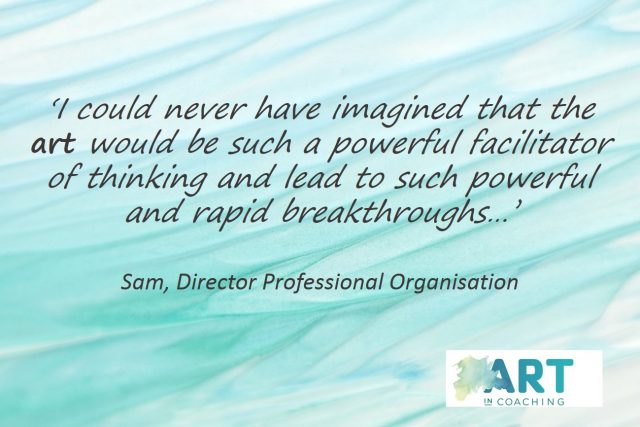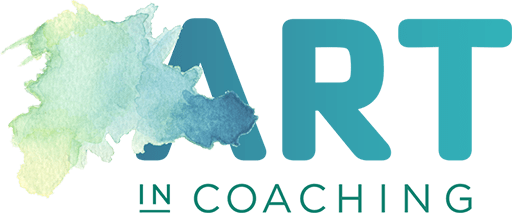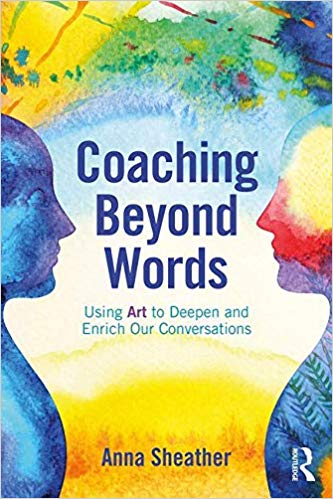Coaching client’s image
In February of this year, before Covid-19 made its presence felt, I started a series of blogs about the very real and complex challenges the changing world is bringing both clients and coaches. These blogs now seem even more relevant than ever.
Art Based Coaching – creating a safe coaching space in unprecedented times
Questioning the very core of us
Covid-19 has brought with it dramatic, fast paced and global changes to the way we live our lives and the way we work. With these changes, which are out of our control, come some very deep and complex emotional responses which, for many, are starting to raise questions about who we are, what is important to us and what we really want from our lives. The nature of these responses and the questions it raises can make it very difficult to make sense of them and, therefore, create new, positive ways of being and thinking in the life we are now living.
These responses will come in to the coaching space, both from our clients as well as from ourselves.
As coaches, when clients bring these challenges, we need to be able to hold a safe space where they can externalise, raise awareness, connect and make sense of what they are experiencing; enabling them to find a way through that feels true for them.
In these new, unprecedented times we need to look to new ways of working with our clients and a new language that allows them to access what they are experiencing, what that means to them and how they want to resolve those experiences. Art based coaching is uniquely placed to do this.
Art Based Coaching
 Art Based Coaching is a very powerful approach enabling clients to work quickly and deeply, unlocking their potential in a creative and dynamic space. Through visual communication and the language of art, art based coaching gives clients a deeper awareness and understanding of the issue at hand, allowing shifts in perspectives that can lead to greater insights and meaning, which in turn can be very transformational. It is an approach that is creative and person centred, whilst also being systemic, embodied and transformational.
Art Based Coaching is a very powerful approach enabling clients to work quickly and deeply, unlocking their potential in a creative and dynamic space. Through visual communication and the language of art, art based coaching gives clients a deeper awareness and understanding of the issue at hand, allowing shifts in perspectives that can lead to greater insights and meaning, which in turn can be very transformational. It is an approach that is creative and person centred, whilst also being systemic, embodied and transformational.
Through the imaging process, art based coaching enables our clients to hold all of what is going on for them in a safe and supported space. Clients can freely express their unconscious and conscious experiences through the physical process of, and non-verbal language of, creating an image. Then once created, the image gives our client something tangible to start working with – something they can see, touch and start to talk about. Their image can hold the whole of what is going on for them in all its complexity – emotional, relational and situational.
The coach, through observation and noticing, can then work alongside their client helping them to explore their image using the language of art. This takes away the pressure from the client of having to label and analyse what is going on for them, giving space for insights, awareness, meaning and words to emerge in their own time.
Working virtually
Art based coaching is always at its best when done together in the same physical space. However, through personal experience, it can also be very effective through a virtual space. I will be talking more about this in a later blog.
A word about trauma
The Covid-19 pandemic is without doubt a traumatic event for everyone across the world. How each person responds to this traumatic event will be different. For some this may trigger deep trauma responses. As coaches we need to be aware of and understand trauma, particularly with art based coaching due to its ability to access hidden memories and experiences that clients may not be ready to or want to explore.
As part of our contracting it is vital that the coaching boundaries are clear and all art based approaches are used with clear purpose and intent. We should also discuss and agree with our clients that some personal history may arise and need to be considered as part of their understanding of how they are responding to the current situation. If a client doesn’t want to include personal histories and narratives, this must be respected.
Talking about personal histories is not the same as going into previous experiences in depth to help resolve them, unless you are qualified to do so. Here our coaching boundaries need to be maintained and we need to be confident in knowing when and how to raise alternative interventions with our clients as appropriate.
It also important that we use our supervision spaces when working with clients where trauma responses may be showing themselves in the coaching space and that we are managing our own responses in a healthy way too.
For more information on trauma in the coaching space I would highly recommend Julia Vaughan Smith’s book ‘Coaching and Trauma – from surviving to thriving’, Open University Press
Art in Coaching workshops – developing your art based coaching practice



